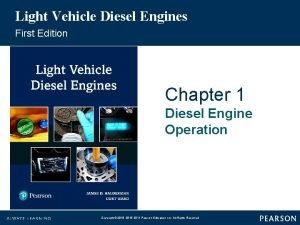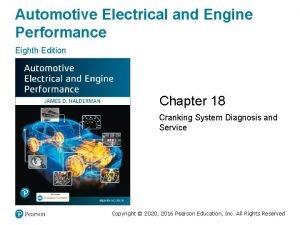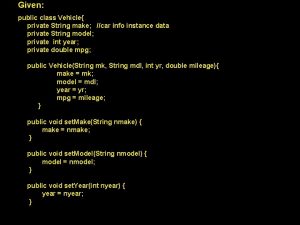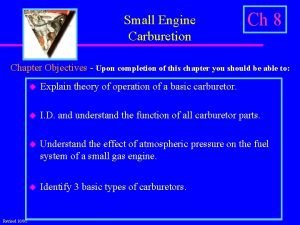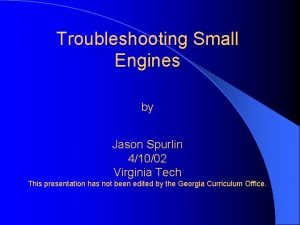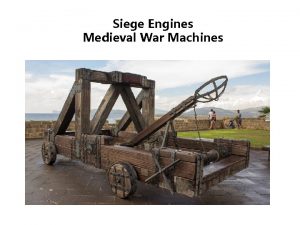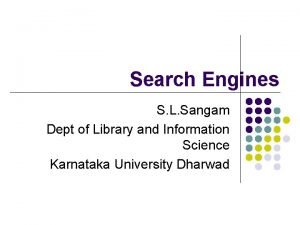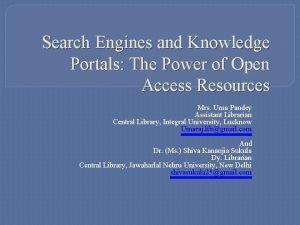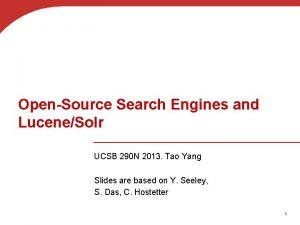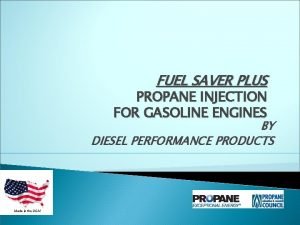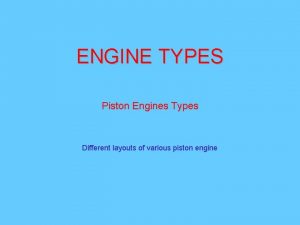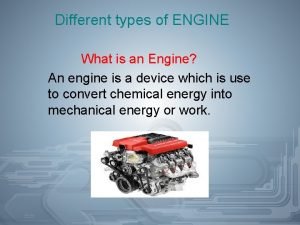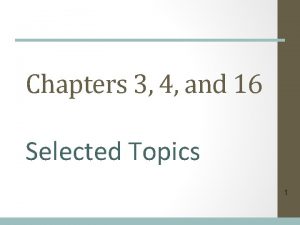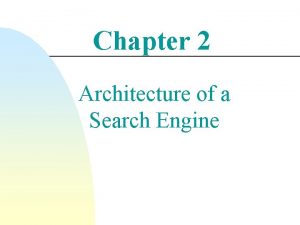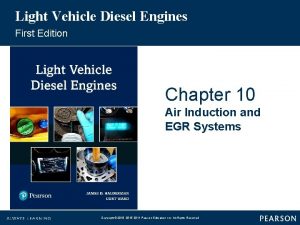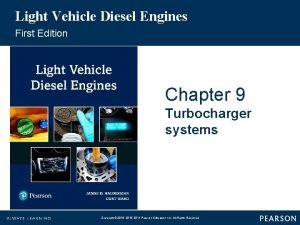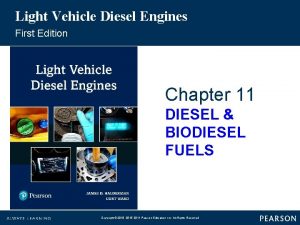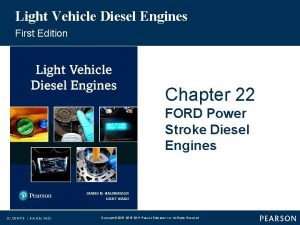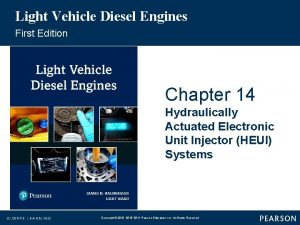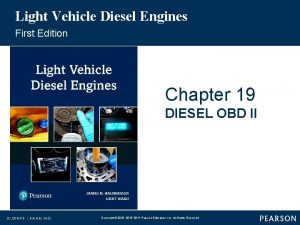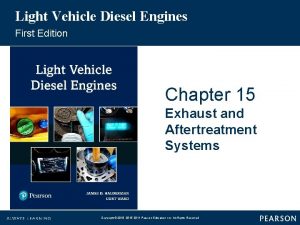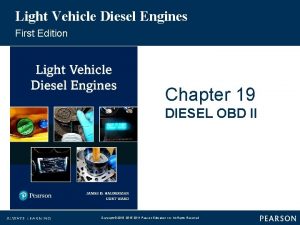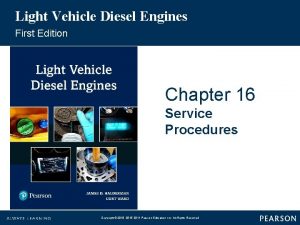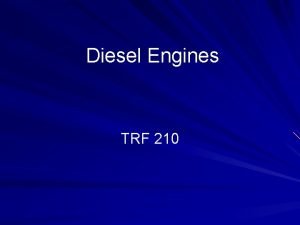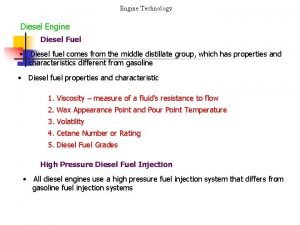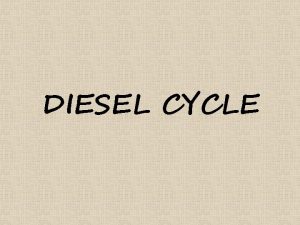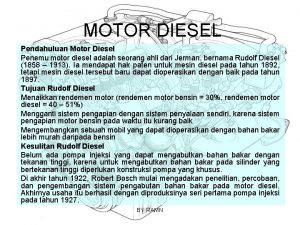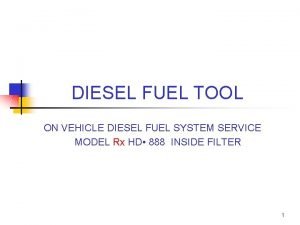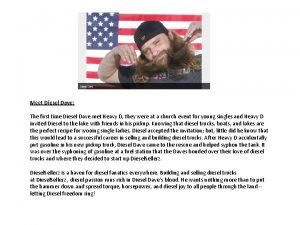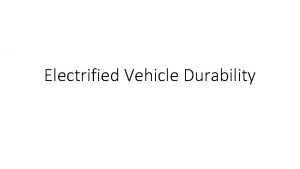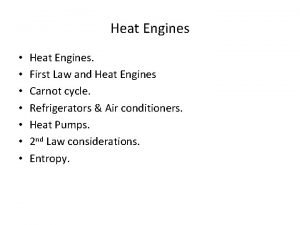Light Vehicle Diesel Engines First Edition Chapter 12






















- Slides: 22

Light Vehicle Diesel Engines First Edition Chapter 12 Fuel Supply and Low Pressure Fuel Systems Copyright © 2018, 2015, 2011 Pearson Education, Inc. All Rights Reserved

LEARNING OBJECTIVES (1 of 1) 12. 1 Prepare for the Light Vehicle Diesel Engine (A 9) ASE certification fuel system diagnosis and repair area (“F”). 12. 2 Describe the function of the low-pressure fuel systems. 12. 3 Identify the components in the low-pressure fuel system. 12. 4 Discuss the need for service and repair of the low pressure fuel system. 12. 5 Explain the need for controlling the temperature of the fuel. Copyright © 2018, 2015, 2011 Pearson Education, Inc. All Rights Reserved

LOW-PRESSURE FUEL SYSTEM COMPONENTS (1 of 2) • Low-Pressure Fuel System Include – – – • • Fuel tank(s) Fuel-level sending unit/Tank pick-up Transfer pump Low-pressure lines Fuel filters/Water separators/Temperature regulators Diesel Fuel Tank Filler Opening Page 135 Fuel Tank Page 135 Fuel-level Sending Unit/Tank Pick-up Page 136 Transfer Pump: Page 136 Copyright © 2018, 2015, 2011 Pearson Education, Inc. All Rights Reserved

LOW-PRESSURE FUEL SYSTEM COMPONENTS (2 of 2) • Low-Pressure Lines – – Presence of air in low-pressure fuel system: Hard starting Low power Rough idle conditions • Fuel Filter Assemblies – Filter elements, water separators – Temperature regulators – Condition diesel fuel for properation Copyright © 2018, 2015, 2011 Pearson Education, Inc. All Rights Reserved

LOW-PRESSURE FUEL SYSTEM SERVICE • Scheduled Maintenance Pages 139 -140 – – Some filters contain integral pin Unseats check ball when properly installed Prevents fuel from flowing if NOT installed Properly installed • Fuel Pressure Testing – Pressure measured after fuel filter(s) – Before it enters high pressure pump • Fuel Volume Testing • Fuel Filter Restriction • Return Volume – Dispose of diesel fuel according to federal, state, local laws. Copyright © 2018, 2015, 2011 Pearson Education, Inc. All Rights Reserved

What Are the Pump Nozzle Sizes? Unleaded gasoline nozzles are smaller than those used for diesel fuel to help prevent fueling errors. However, it is still possible to fuel a diesel vehicle with gasoline. SEE CHART 12– 1 for sizes and colors used for fuel pump nozzles. Copyright © 2018, 2015, 2011 Pearson Education, Inc. All Rights Reserved

CHART 12 -1 Fuel pump nozzle size standardized except for use by over-the road truck stops where high fuel volumes and speedy refills require larger nozzles compared to passenger vehicle station nozzles. Copyright © 2018, 2015, 2011 Pearson Education, Inc. All Rights Reserved

FIGURE 12– 1 fuel tank is used to store the fuel and to allow fuel to recirculate from the return system, and cool after absorbing heat from the high-pressure pump and the injectors. Copyright © 2018, 2015, 2011 Pearson Education, Inc. All Rights Reserved

FIGURE 12– 2 jet pump siphons fuel from the opposite side of the saddle tank to ensure the supply pump delivers fuel to the engine from both sides of the tank equally Copyright © 2018, 2015, 2011 Pearson Education, Inc. All Rights Reserved

FIGURE 12– 3 fuel pump module contains the low-pressure pump and regulator, the fuel-level sending unit, and tank pick-up. Copyright © 2018, 2015, 2011 Pearson Education, Inc. All Rights Reserved

FIGURE 12– 4 lift pump pushes fuel through filtration system to high-pressure pump at correct pressure and with adequate volume. Copyright © 2018, 2015, 2011 Pearson Education, Inc. All Rights Reserved

FIGURE 12– 5 low-pressure pump can be an in-tank or out-of-tank variety, depending on the system design. Copyright © 2018, 2015, 2011 Pearson Education, Inc. All Rights Reserved

FIGURE 12– 6 Many manufacturers recommend that water be drained once a month to ensure there is no damage to the high-pressure fuel system. Copyright © 2018, 2015, 2011 Pearson Education, Inc. All Rights Reserved

FIGURE 12– 7 second filter in a dual filter system is located on engine assembly. Both filters are replaced at same time following recommended service procedures. Copyright © 2018, 2015, 2011 Pearson Education, Inc. All Rights Reserved

FIGURE 12– 8 fuel heater keeps the fuel from gelling in cold weather. Copyright © 2018, 2015, 2011 Pearson Education, Inc. All Rights Reserved

FIGURE 12– 9 fuel cooler is used to control density of fuel so that high temperatures do not have a negative effect on engine performance. Copyright © 2018, 2015, 2011 Pearson Education, Inc. All Rights Reserved

FIGURE 12– 10 water-in-fuel sensor uses electrical conductivity to sense the water in the fuel. If the conductivity is above a specific level, the warning lamp on the dash is illuminated. Copyright © 2018, 2015, 2011 Pearson Education, Inc. All Rights Reserved

FIGURE 12– 11 low-pressure fuel system can be tested with a traditional fuel pressure gauge and the required adapters. Copyright © 2018, 2015, 2011 Pearson Education, Inc. All Rights Reserved

FIGURE 12– 12 low-pressure pump is being tested for adequate volume. Copyright © 2018, 2015, 2011 Pearson Education, Inc. All Rights Reserved

FIGURE 12– 13 return volume from the injectors and the high-pressure pump is being measured. Copyright © 2018, 2015, 2011 Pearson Education, Inc. All Rights Reserved

Summary (1 of 2) • The low-pressure fuel system is used to store and supply clean fuel in adequate volume and at the correct pressure to the high-pressure fuel system. • The system contains filters to remove foreign material from the fuel before it enters the highpressure system. It contains heaters to ensure the fuel flows properly during cold temperatures, and a cooler to ensure the fuel is at the proper density. This does not affect engine performance. Copyright © 2018, 2015, 2011 Pearson Education, Inc. All Rights Reserved

Summary (2 of 2) • The maintenance of the low-pressure fuel system is critical to the operation and the longevity of the high-pressure fuel system. • An excess of fuel being returned to the tank via the low pressure return can indicate a failure in the high-pressure system. Copyright © 2018, 2015, 2011 Pearson Education, Inc. All Rights Reserved
 Light vehicle diesel engines
Light vehicle diesel engines Automotive engines 8th edition
Automotive engines 8th edition Light light light chapter 23
Light light light chapter 23 Into the light chapter 22
Into the light chapter 22 Chapter 22
Chapter 22 Private string java
Private string java Chapter 8 carburetion answers
Chapter 8 carburetion answers Chapter 5 principles of engine operation
Chapter 5 principles of engine operation Mis chapter 6
Mis chapter 6 Using mis (10th edition)
Using mis (10th edition) When sharing the road with a light rail vehicle you
When sharing the road with a light rail vehicle you Troubleshooting small engines
Troubleshooting small engines Siege engines
Siege engines Advantages and disadvantages of meta search engines
Advantages and disadvantages of meta search engines Knowledge search engines
Knowledge search engines Meta search engine definition
Meta search engine definition Open source search engines
Open source search engines Propane injection
Propane injection Types of piston
Types of piston What is engine displacement
What is engine displacement Harper industries has $900 million of common equity
Harper industries has $900 million of common equity Architecture of search engine
Architecture of search engine Other search engines
Other search engines
